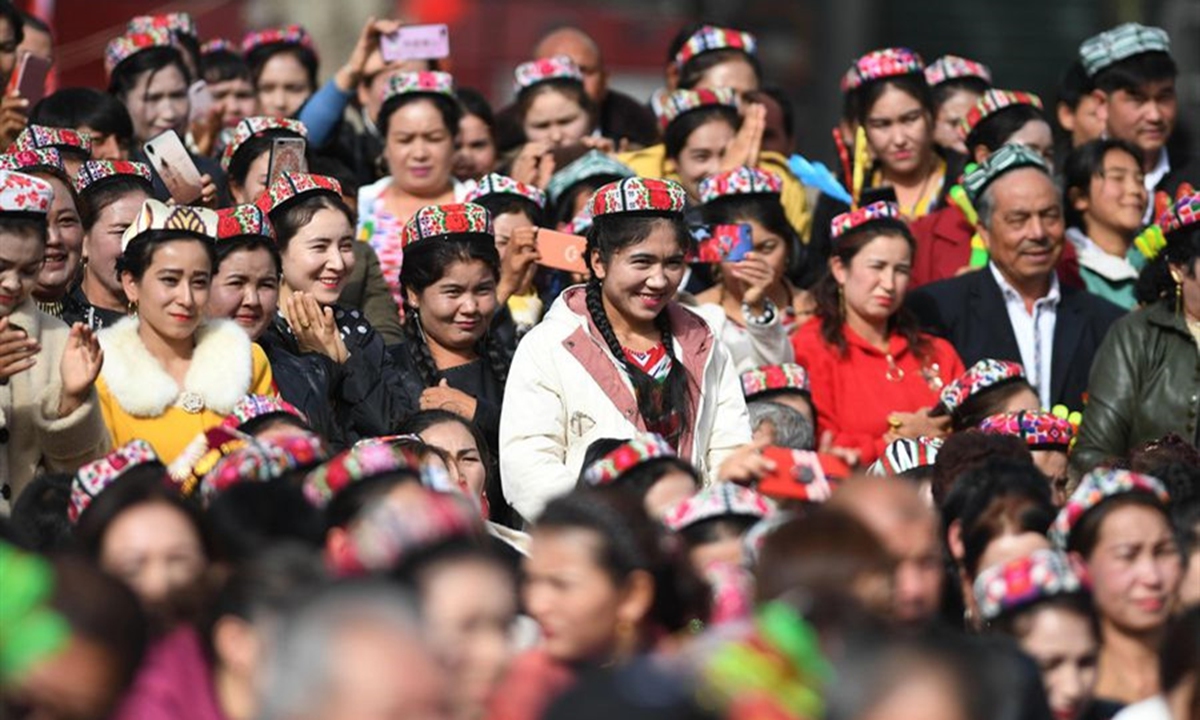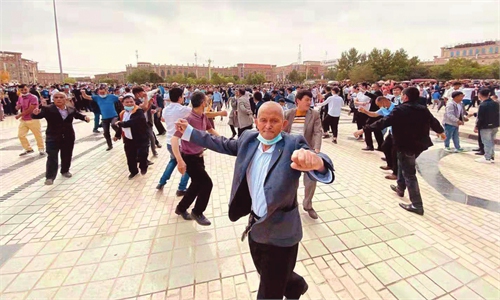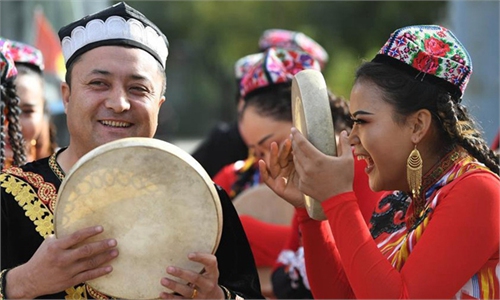West misreads census data to support fallacious 'genocide' claim
Report uses 2016-19 data to erroneously show decade shift of population

Xinjiang Photo: Xinhua
Population data of Northwest China's Xinjiang Uygur Autonomous Region from the seventh national census was used by anti-China forces and media as new ingredients to cook up their old lies of "genocide" in the region, and their "cookbook recipe" remains the same - misinterpreting data and drawing hasty and fallacious conclusions to mislead an audience who does not dig into their reports and examine the logic carefully.
On Tuesday, China released the latest national census data, which showed that the number of people living in Xinjiang region was 25.9 million last year, up 2.5 percent from a year earlier and an increase of 18.3 percent from the sixth national census in 2010.
Detailed demographic data, including the population of each ethnic group, birth rate and population by age group in the region has not been released yet, however, some media and anti-China forces have already used the data as new "proof" to smear China for "repressing" the birth rates of ethnic groups, especially the Uygurs.
For example, the South China Morning Post claimed in its Wednesday report that Xinjiang Production and Construction Corps (XPCC) had a quick expansion that contributed to Xinjiang's 18.3 percent population growth in the past decade.
The newspaper said Xinjiang's population increased 1.25 million between 2016 and 2019, one third of the increase from the XPCC.
By listing 18.3 percent and one third together, the SCMP tried to sell the idea to its readers that Xinjiang's population growth is driven by the XPCC expansion which comprises of Han people, with the regional population transitioning showing a higher proportion of Han residents.
But the Global Times, through calculations of yearly data, found the argument cannot stand, contradicting the actual situation of Han and minority populations.
As Uygurs comprise the largest part of the region's population, the Global Times analyzed the datasets for Uygurs and Han Chinese from 2010 to 2019, only to find the XPCC population grew 640,000, about 18.7 percent of the region's 3.42 million increase.
It is problematic to use the 2016-19 increase to indicate the 10-year trend or use an untypical section of data to represent future trends, analysts said.
The Global Times also calculated the rate of Uygurs to Han Chinese, which was 1.22 in 2010 and 1.49 in 2018, meaning the proportion of Uygurs actually increased in contrast to what the SCMP indicated.
Latest lies
Following the SCMP report, the notorious Australian Strategic Policy Institute (ASPI), the "right-wing, militaristic" think tank funded by the US and Western governments, mega-corporations and an eye-popping array of weapons manufacturers, also released a report on Wednesday, saying that Xinjiang is launching a "coercive campaign to drive down the indigenous birth-rate in Xinjiang."
It claimed that an "unprecedented and precipitous drop in official birth-rates" in Xinjiang from 2017 to 2019 evidenced the campaign to cut "illegal births." And the sharp decline of birth rates only happened in majority-indigenous counties.
Experts condemned ASPI's latest report as "new bottle old wine," attempting to maliciously use the birth rate decline since 2017 to accuse China of "committing genocide" against Uygurs.
Li Xiaoxia, a special researcher at the Xinjiang Development Research Center, had explained in a report released in January that the main reason behind the decline is a shift of thinking on marriage and childbearing brought on by social development and progress, the implementation of the family planning policy and the curbing of religious extremism, Li noted in her report.
Zhou Weiping, an expert from the Institute of China's Borderlands of the Chinese Academy of Social Sciences who studies Xinjiang's population, said that China previously adopted favorable population policies toward ethnic minorities in certain areas but with social development and the increase of educational attainment, ethnic groups have begun to choose to have less children to improve the quality of family life. Women from ethnic groups have started to take contraceptive measures voluntarily.
"This is why countries all over the world go through changes of fertility after social and economic development. But now similar changes in Xinjiang have been interpreted as 'forced sterilization' by the US. Some Western countries have much lower fertility rates, does this indicate that their governments force women to be sterilized?" Zhou asked.
Zhou told the Global Times that Xinjiang adopted unified family planning policy from 2017 onwards to fit the social consensus on "having less but better children." With the development of every ethnic group in China, all policies, including those regarding population would become equal.
The policy, implemented across Chinese mainland, stipulates that all ethnic groups implement a unified family planning policy, which means that one urban couple is allowed to have two children and one rural couple is allowed to have three children.
The ASPI report attributed the falling birth rate to "forced birth control," but the reasons behind the declining birth rate are complex. Having fewer children are the spontaneous choices of Uygur women as their rights are better protected and they no longer need to be restricted to households, Jia Chunyang, an expert at the China Institutes of Contemporary International Relations, told the Global Times on Thursday.
Dropping birth rates come as a result of economic development and improving women rights, which is a common phenomenon in all societies. Uygur women now can walk out of home and work to improve their economic and social status, rather than be bound to their homes raising five to eight children.
Jia noted that some so-called scholars are skillful in misinterpreting data and making misleading judgements. Many readers would jump to a conclusion without thinking carefully regarding the logical fallacy.
Demographers also pointed out that the crude birth rate, which has been used in the ASPI report cannot accurately show the population development, not to mention using crude birth rates of a single county to over generalize the situation of southern Xinjiang prefectures, and more hastily, the entirety of Xinjiang, is definitely untenable.
Data on the Han population, Uygurs and other ethnic groups also run contrary to ASPI's pre-set argument of population structure transformation and "genocide," the institute has picked the crude birth rate, children born to each 1,000 residents, to demonstrate its pre-set argument of "genocide."
According to data from Xinjiang authorities, from 2010 to 2018, the population of ethnic minorities increased from 12.99 million to more than 15.86 million, with the Uygur population increasing from 10.17 million to 12.72 million - much higher than that of the Han population.
The ASPI report came at a time when China just released data from its seventh national census and some countries are appropriating the UN venue to hype the Xinjiang topic, which again demonstrated the West's continuous efforts to use Xinjiang as a "handle" to attack China.
The report's acknowledgment also exposed its intention not to assist Xinjiang's people but to help the US and anti-China forces amplify the current "genocide" lies against China, and told enough about nature of the report, observers said.
The infamous pseudo-scholar Adrian Zenz, who suddenly became a "Xinjiang expert" without any academic accumulation has been listed as an "external peer examiner," and the acknowledgement also thanked the financial support received from the US State Department and the UK Foreign Affairs and Commonwealth Office.




